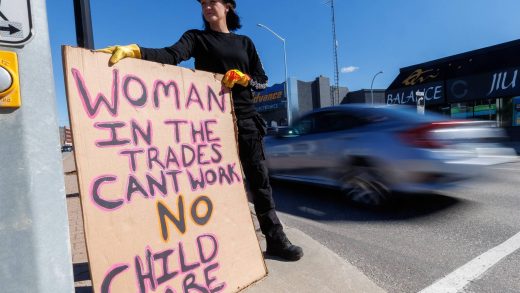
SEOUL, South Korea (AP) — North Korea was silent about the highly unusual entry of an American soldier across the Koreas’ heavily fortified border although it test-fired short-range missiles Wednesday in its latest weapons display.
More than half a day after the soldier bolted into North Korea during a tour in the border village of Panmunjom, there was no word on the fate of Private 2nd Class Travis King, the first known American detained in the North in nearly five years. The North’s missile launches Wednesday morning were seen as a protest of the deployment of a U.S. nuclear-armed submarine in South Korea the previous day and weren’t likely related to King’s border crossing.
“It’s likely that North Korea will use the soldier for propaganda purposes in the short term and then as a bargaining chip in the mid-to-long term,” said Yang Moo-jin, president of the University of North Korean Studies in South Korea.

King, 23, was a cavalry scout with the 1st Armored Division who had served nearly two months in a South Korean prison for assault. He was released on July 10 and was being sent home Monday to Fort Bliss, Texas, where he could have faced additional military discipline and discharge from the service.
He was escorted as far as customs but left the airport before boarding his plane. It wasn’t clear how he spent the hours until joining the Panmunjom tour and running across the border Tuesday afternoon. The Army released his name and limited information after King’s family was notified. But a number of U.S. officials provided additional details on condition of anonymity because of the sensitivity of the matter.
At a Pentagon news conference, Defense Secretary Lloyd Austin confirmed King was likely now in North Korean custody.
“We’re closely monitoring and investigating the situation,” Austin said, noting he was foremost concerned about the troop’s well-being. “This will develop in the next several days and hours, and we’ll keep you posted.”
Prospects for King’s early release are unclear, as some observers say it’s likely for North Korea to use him for propaganda or a tool to win diplomatic concessions from the United States.
The American-led U.N. Command said he is believed to be in North Korean custody and the command is working with its North Korean counterparts to resolve the incident.
Cases of Americans or South Koreans defecting to North Korea are rare, though more than 30,000 North Koreans have fled to South Korea to avoid political oppression and economic difficulties since the end of the 1950-53 Korean War.
Panmunjom, located inside the 248-kilometer-long (154-mile) Demilitarized Zone, has been jointly overseen by the U.N. Command and North Korea since its creation at the close of the Korean War. Bloodshed has occasionally occurred there, but it has also been a venue for diplomacy and tourism.
Known for its blue huts straddling concrete slabs that form the demarcation line, Panmunjom draws visitors from both sides who want to see the Cold War’s last frontier. No civilians live at Panmunjom. North and South Korean soldiers face off while tourists on both sides snap photographs.
Tours to the southern side of the village reportedly drew around 100,000 visitors a year before the coronavirus pandemic, when South Korea restricted gatherings to slow the spread of COVID-19. The tours resumed fully last year.
In November 2017, North Korean soldiers fired 40 rounds as one of their colleagues raced toward the South. The soldier was hit five times before he was found beneath a pile of leaves on the southern side of Panmunjom. He survived and is now in South Korea.
The most famous incident at Panmunjom happened in August 1976, when two American army officers were killed by ax-wielding North Korean soldiers. The U.S. officers had been sent to trim a tree that obstructed the view from a checkpoint. The attack prompted Washington to fly nuclear-capable B-52 bombers toward the DMZ to intimidate North Korea.
A small number of U.S. soldiers who went to North Korea during the Cold War, including Charles Jenkins, who deserted his army post in South Korea in 1965 and fled across the DMZ. He appeared in North Korean propaganda films and married a Japanese nursing student who had been abducted from Japan by North Korean agents. He died in Japan in 2017.
In recent years, some American civilians have been arrested in North Korea for alleged espionage, subversion and other anti-state acts, but were released after the U.S. sent high-profile missions to secure their freedom.
In May 2018, North Korea released three American detainees who returned to the United States on a plane with then-Secretary of State Mike Pompeo during a short period of warm relations. Later in 2018, North Korea said it expelled American Bruce Byron Lowrance. Since his ouster, there have been no reports of other Americans detained in North Korea before Tuesday’s incident.
Their freedoms were a striking contrast to the fate of Otto Warmbier, an American university student who died in 2017 days after he was released by North Korea in a coma after 17 months in captivity.
The United States, South Korea and others have accused North Korea of using foreign detainees to wrest diplomatic concessions. Some foreigners have said after their release that their declarations of guilt were coerced while in North Korean custody.
Sean Timmons, a managing partner at the Tully Rinckey law firm, which specializes in military legal cases, said if King is trying to present himself as a legitimate defector fleeing either political oppression or persecution, he would be dependent on North Korea’s leadership to decide if he can stay.
He said it will likely be up to North Korean leader Kim Jong Un to decide King’s fate.
“It’s going to be up to the whims of their leadership, what they want to do,” Timmons said.
___
Copp reported from Washington. Associated Press writers Matthew Lee and Zeke Miller in Washington contributed to this report.


